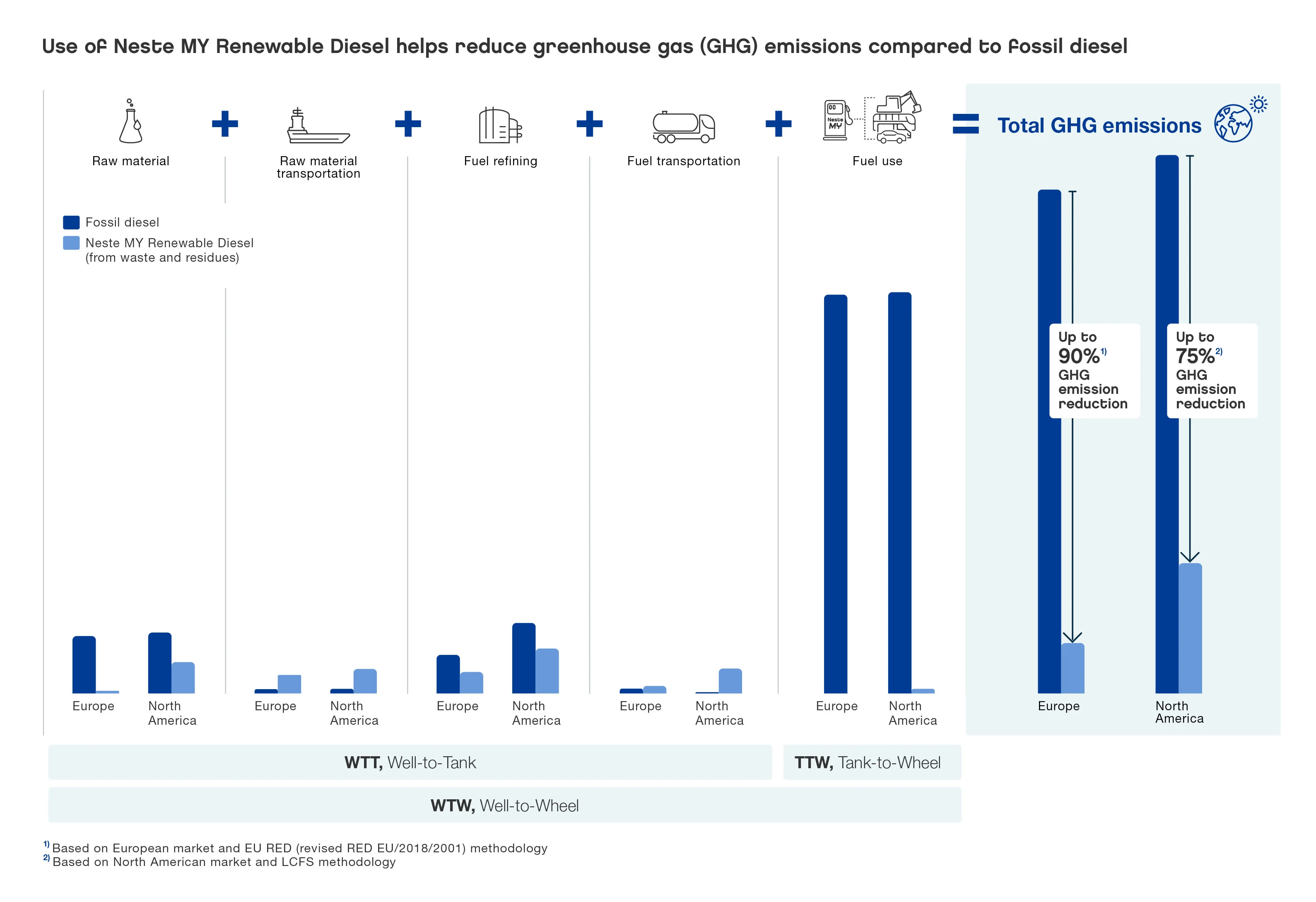
What is HVO?
HVO stands for Hydrotreated Vegetable Oil, also known as renewable diesel. Neste refers to its renewable diesel HVO100 fuel as Neste MY Renewable DieselTM. It is produced from 100% renewable raw materials.

What is Neste MY Renewable Diesel?
Neste MY Renewable Diesel can also be referred to as HVO100 or HVO diesel. Neste MY Renewable Diesel is produced from 100% renewable raw materials, such as used cooking oil and animal fat waste. With the use of Neste MY Renewable Diesel, greenhouse gas (GHG) emissions can be reduced by up to 90%* or by up to 75%** when emissions over the fuel’s life cycle are compared to fossil diesel.
HVO fuel comes in all kinds of blends. It can be used pure (100% concentration), as well as blended in any ratio with fossil diesel. Neste MY Renewable Diesel is an HVO100 product, meaning HVO in its purest form. In addition, it complies with the EN15940 specification for paraffinic diesel fuel.
How is HVO made at Neste?

Sourcing renewable raw materials globally
Neste uses a wide variety of raw materials to produce Neste MY Renewable Diesel. Waste and residues account for approximately 90% of Neste’s renewable raw material usage globally.
Proportions of individual raw materials vary year-to-year and across regions, depending on their availability, price, and market-specific requirements.
However, the top three ingredients in Neste MY Renewable Diesel are usually animal fat waste, used cooking oil, and different wastes and residues from vegetable oil processing.

Purifying to create pure HVO100
Renewable raw materials are pre-treated to remove impurities.

Harnessing NEXBTL innovation
To produce Neste MY Renewable Diesel, we turn a wide variety of renewable fats and oils into high-quality renewable products with our proprietary NEXBTL™ technology. Turning diverse renewable raw materials into pure hydrocarbons requires several process steps. In the process steps, the renewable raw material is converted to hydrocarbon product with similar energy density and properties as regular fossil diesel.
Drive on Neste MY Renewable Diesel
The end result? Neste MY Renewable Diesel, a pure HVO100 fuel. With the use of Neste MY Renewable Diesel, greenhouse gas emissions can be reduced by up to 90%* or by up to 75%** when emissions over the fuel’s life cycle are compared to fossil diesel.
A high-performance, OEM-approved solution you can use in any diesel engine neat, or blended at any ratio with fossil diesel.
HVO vs. biodiesel
Neste MY Renewable Diesel (HVO) and FAME biodiesel are both made from renewable raw materials. However, biodiesel, a fatty acid methyl ester (FAME) product, is not a pure hydrocarbon. Biodiesel’s compatibility is much more limited. Most biodiesel can only be used in a low blend – for example up to 7% under European standard EN 15490 and 5% under US standard ASTM D975 2-D***.
As a pure hydrocarbon, Neste MY Renewable Diesel is chemically similar to fossil diesel, which means it can be used in any diesel engine without any modifications, neat or blended at any ratio.
Plus, its high cetane number allows the fuel to combust with maximum efficiency, and keeps the engine cleaner than FAME biodiesel.
A HVO100 fuel – HVO in its purest form – also does not attract water. With proper handling and storage, this means minimal risk of deterioration or microbial growth, leading to longer storage capabilities.
Neste MY Renewable Diesel (HVO)**** | Fossil diesel | Biodiesel b20 | |
|---|---|---|---|
GHG emissions reduction | Up to 90%* or up to 75%** | 0 | 15% |
Renewable raw materials | 100% | No | Yes |
Performance in cold weather | Excellent | Excellent | Depends |
Cetane number | 70+ | 45-55 | 50 |
Fuel stability | High | Average | Low |
OEM approval | Yes | Yes | Yes |
How are emissions for HVO calculated
The use of Neste MY Renewable Diesel (HVO), made from 100% renewable raw materials, can reduce greenhouse gas (GHG) emissions by up to 90%* or by up to 75%** when emissions over the fuel’s life cycle are compared to fossil diesel. Make a difference today by switching to renewable diesel.
The calculations follow the well-to-wheels principle, which means that all GHG emissions over the full life cycle of the renewable diesel are taken into account and compared with the GHG emissions over the entire fossil diesel life cycle. In addition to the GHG emissions from fuel use, the life cycle emissions include also the emissions associated with the extraction or production of raw materials, fuel refining, and emissions from all logistics of the raw materials and the end product.

Neste MY Renewable Diesel
*) In Europe and Asia-Pacific, calculation method EU RED III (revised RED EU/2018/2001) **) In the US, calculation method US California LCFS The GHG emission reduction varies depending on the region-specific legislation that provides the methodology for the calculations, as well as the raw material mix used to manufacture the product for each market.
***) The European standard for diesel fuels (DIN EN 15490) limits the biodiesel content (FAME DIN EN 14214) to a maximum of 7%. The US standard for diesel fuels (D975) limits the biodiesel content to a maximum of 5%.Indeed, engine and vehicle manufacturers are widely supporting the development of HVO fuels as a way to increase the share of renewable diesel fuels and reduce emissions without the concerns associated with FAME.
****) The characteristics of Neste-sold renewable diesel may vary from market to market.